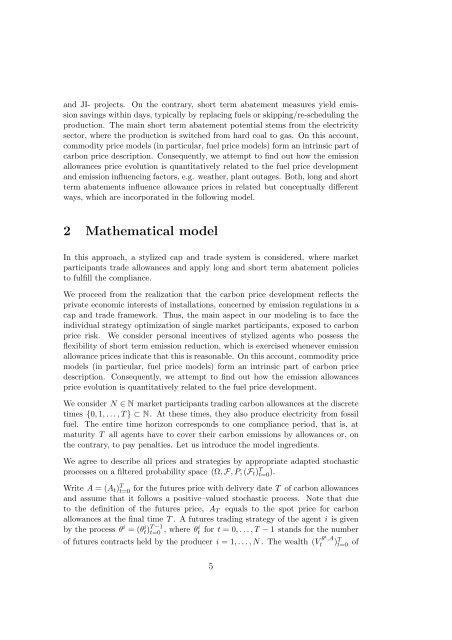A quantitative approach to carbon price risk modeling - CiteSeerX
A quantitative approach to carbon price risk modeling - CiteSeerX
A quantitative approach to carbon price risk modeling - CiteSeerX
You also want an ePaper? Increase the reach of your titles
YUMPU automatically turns print PDFs into web optimized ePapers that Google loves.
and JI- projects. On the contrary, short term abatement measures yield emission<br />
savings within days, typically by replacing fuels or skipping/re-scheduling the<br />
production. The main short term abatement potential stems from the electricity<br />
sec<strong>to</strong>r, where the production is switched from hard coal <strong>to</strong> gas. On this account,<br />
commodity <strong>price</strong> models (in particular, fuel <strong>price</strong> models) form an intrinsic part of<br />
<strong>carbon</strong> <strong>price</strong> description. Consequently, we attempt <strong>to</strong> find out how the emission<br />
allowances <strong>price</strong> evolution is <strong>quantitative</strong>ly related <strong>to</strong> the fuel <strong>price</strong> development<br />
and emission influencing fac<strong>to</strong>rs, e.g. weather, plant outages. Both, long and short<br />
term abatements influence allowance <strong>price</strong>s in related but conceptually different<br />
ways, which are incorporated in the following model.<br />
2 Mathematical model<br />
In this <strong>approach</strong>, a stylized cap and trade system is considered, where market<br />
participants trade allowances and apply long and short term abatement policies<br />
<strong>to</strong> fulfill the compliance.<br />
We proceed from the realization that the <strong>carbon</strong> <strong>price</strong> development reflects the<br />
private economic interests of installations, concerned by emission regulations in a<br />
cap and trade framework. Thus, the main aspect in our <strong>modeling</strong> is <strong>to</strong> face the<br />
individual strategy optimization of single market participants, exposed <strong>to</strong> <strong>carbon</strong><br />
<strong>price</strong> <strong>risk</strong>. We consider personal incentives of stylized agents who possess the<br />
flexibility of short term emission reduction, which is exercised whenever emission<br />
allowance <strong>price</strong>s indicate that this is reasonable. On this account, commodity <strong>price</strong><br />
models (in particular, fuel <strong>price</strong> models) form an intrinsic part of <strong>carbon</strong> <strong>price</strong><br />
description. Consequently, we attempt <strong>to</strong> find out how the emission allowances<br />
<strong>price</strong> evolution is <strong>quantitative</strong>ly related <strong>to</strong> the fuel <strong>price</strong> development.<br />
We consider N ∈ N market participants trading <strong>carbon</strong> allowances at the discrete<br />
times {0, 1, . . . , T } ⊂ N. At these times, they also produce electricity from fossil<br />
fuel. The entire time horizon corresponds <strong>to</strong> one compliance period, that is, at<br />
maturity T all agents have <strong>to</strong> cover their <strong>carbon</strong> emissions by allowances or, on<br />
the contrary, <strong>to</strong> pay penalties. Let us introduce the model ingredients.<br />
We agree <strong>to</strong> describe all <strong>price</strong>s and strategies by appropriate adapted s<strong>to</strong>chastic<br />
processes on a filtered probability space (Ω, F, P, (F t ) T t=0 ).<br />
Write A = (A t ) T t=0 for the futures <strong>price</strong> with delivery date T of <strong>carbon</strong> allowances<br />
and assume that it follows a positive–valued s<strong>to</strong>chastic process. Note that due<br />
<strong>to</strong> the definition of the futures <strong>price</strong>, A T equals <strong>to</strong> the spot <strong>price</strong> for <strong>carbon</strong><br />
allowances at the final time T . A futures trading strategy of the agent i is given<br />
by the process θ i = (θt) i T t=0 −1 , where θi t for t = 0, . . . , T − 1 stands for the number<br />
of futures contracts held by the producer i = 1, . . . , N . The wealth (V θi ,A<br />
t ) T t=0 of<br />
5
















